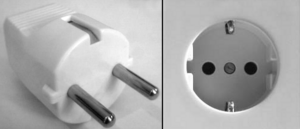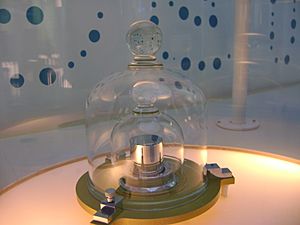Standardization facts for kids
People and companies need to agree on common rules and ways to measure things so they can work together. These agreements are called standards. The process of making these agreements is called standardization.
When companies follow these rules, their products can work together. For example, a two-pin electrical plug is a standard. It provides electricity and is used in many homes around the world. This means you can often use the same appliance in different countries if they share this plug type. However, three-pin plugs are different in almost every country, which can be tricky!
Agreements don't always have to be about technology. Lawyers might agree on a standard way to solve a problem. Language experts can agree on what a "standard language" is. Even bookkeepers agree on rules for how to figure out a company's value.

Contents
What Are Standards and Why Do We Need Them?
Standards are like a set of agreed-upon rules or guidelines. They help make sure that products, services, and ways of doing things are consistent and safe. Imagine if every light bulb had a different size base, or if every phone charger was unique! Standards prevent this confusion.
How Do Standards Help Us Every Day?
Standards make our lives easier and safer. They allow different products to connect and work together. For example, when you buy a new light bulb, you know it will fit into your lamp because of standard socket sizes. When you use a USB cable, you know it will connect your phone to your computer, no matter who made them.
Making Products Work Together
Standards are super important for making sure things are compatible. Think about a game console and its controller. If they didn't follow the same standards, they wouldn't be able to "talk" to each other. Standards ensure that different parts or products can connect and function as expected.
Ensuring Safety and Quality
Many standards are about safety. For instance, electrical plugs and sockets have standards to prevent shocks and fires. Food products have standards for how they are made and stored to keep us healthy. Standards also help ensure that products meet a certain level of quality.
Who Creates Standards?
Standards are often created by special organizations. These groups bring together experts from different companies, governments, and research institutions. They discuss and agree on the best ways to do things.
Important Standardization Organizations
There are many organizations that create standards. Some are international, meaning they work worldwide, while others focus on specific countries or industries.
International Standards Organizations
One of the most well-known international organizations is the International Organization for Standardization (ISO). ISO creates standards for almost everything, from quality management to environmental practices. Another important one is the International Electrotechnical Commission (IEC), which focuses on electrical and electronic technologies.
National Standards Bodies
Each country often has its own national standards body. For example, in the United States, there's the American National Standards Institute (ANSI). In Germany, it's the Deutsches Institut für Normung (DIN). These national bodies often adopt international standards or create their own for specific local needs.
History of Standardization
The idea of standards isn't new. People have been trying to agree on common measurements and practices for thousands of years.
Early Examples of Standards
Long ago, people needed standard ways to measure things for trade and building. Ancient civilizations used standard units for length, weight, and volume. For example, the length of a "foot" or an "ell" (the length of a forearm) was often standardized in different regions.
The Industrial Revolution and Standards
The Industrial Revolution in the 18th and 19th centuries made standards even more important. Factories started making many parts that needed to fit together perfectly. This led to the development of things like standard screw threads, so that nuts and bolts from different makers could be used together.
Images for kids
-
Henry Maudslay's famous early screw-cutting lathes from around 1797 and 1800. These machines helped create standard screw threads.
-
A memorial plaque in Prague for the founding of the International Federation of National Standardizing Associations (ISA), an early standards group.
See also
 In Spanish: Normalización para niños
In Spanish: Normalización para niños






